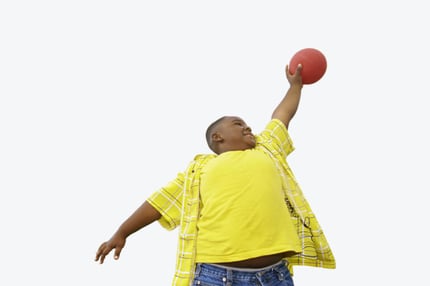Originally published in the Winter 2020 issue of American Fitness Magazine.

Lack of physical activity and an increase in sedentary behaviors are leading an overall upward trend in obesity, but the effects on children and adolescents are especially alarming. Today, obesity-associated disorders previously found only in adults—high blood pressure and type 2 diabetes, for example—are now commonly seen in children.
Due to the prevalence of comorbidities linked to obesity and sedentary behaviors, the current generation of children may be the first in history to have a life expectancy shorter than that of their parents (AHA 2018).
Perhaps it is of little surprise, then, that childhood obesity is the primary concern among parents in the United States, surpassing both drug use and smoking (AHA 2018; IHRSA 2017). This may, in fact, be the reason parents bring their children to Youth Exercise Specialists and Youth Sports Coaches to help with adopting healthier habits in respect to nutrition and physical activity.
Since this special population brings with it special considerations, this article will go into greater detail on the specific effects of extra weight on children’s health and quality of life. It will also review some of the most common contributors to overweight and obesity in children—beyond a lack of good nutrition—and provide guidance on the steps that fitness professionals can take to begin turning the tide.
The Prevalence of Childhood Obesity
 A 2018 report from the World Health Organization found that, in 2016, an estimated 41 million children under the age of 5 were diagnosed as overweight or obese—a 60% increase from 1990 (WHO 2018; Kelsey et al. 2014). In the United States, in fact, children are the fastest-growing subpopulation of individuals with obesity: 1 in 3 children is now considered overweight or obese (Nowicki et al. 2019).
A 2018 report from the World Health Organization found that, in 2016, an estimated 41 million children under the age of 5 were diagnosed as overweight or obese—a 60% increase from 1990 (WHO 2018; Kelsey et al. 2014). In the United States, in fact, children are the fastest-growing subpopulation of individuals with obesity: 1 in 3 children is now considered overweight or obese (Nowicki et al. 2019).Income and ethnicity also play a role. The prevalence is higher in lower-income households. Obesity rates in the African-American and Hispanic populations are 50%–75% higher than for Caucasians, whereas rates are 30% lower in the Asian population (also compared with Caucasians) (Nowicki et al. 2019).
The Impact on Mind, Body and Behavior
Obesity during childhood can have a detrimental effect on quality of life in a variety of ways, leading to psychological, social and behavioral issues, as well as physical issues. For example, one study indicated that clinically overweight girls in kindergarten were 81% more likely to have behavior problems, possibly caused by the stigma associated with childhood obesity (Pulgarón 2013). Another study concluded that children who were overweight were more likely to be victims of bullying and discrimination (Bacchini et al. 2015).
Of course, like adults, children can also suffer from the physical outcomes of excess weight, such as high cholesterol, high blood pressure, metabolic syndrome and type 2 diabetes. What’s more, because children are still learning and growing, they experience additional issues related to having a high body mass index. For example, according to Nowicki et al., “The entire hormonal axis is affected in obese children, with complex interactions leading to not only growth differences but early pubertal differences as well.”
Here are some additional physical consequences associated with obesity and overweight in children:

Musculoskeletal Issues
A higher BMI and lack of physical activity are associated with increased risk for lower-extremity fractures, posture problems and alterations in bone metabolism, which can cause physiological changes to the growing skeleton. Specifically, increased body weight strongly affects attainment of peak bone mass (Nowicki et al. 2019). Nowicki and colleagues explain that these risks are significant because lifelong skeletal health can depend on maximizing bone mass accrual during childhood, and 40% of bone mineral accrual occurs within 2 years of the adolescent growth spurt.
Numerous studies have also documented an association between obesity and higher risk of musculoskeletal injuries, with risk rising as weight increases (Kessler et al. 2013). For example, children with obesity are 25% more likely to experience an extremity fracture (Dimitri 2019), and 2- to 5-year-olds who are considered “extremely obese” have more than double the fracture risk of children of normal weight (Nowicki et al. 2019). Fracture risk may be higher for children with obesity partly because they are more likely to fall—due to postural, balance and mobility limitations—and partly because they have difficulty in bracing against falls when they happen.
Brain Development and Cognitive Function
Obesity during childhood can greatly influence brain development, and researchers have argued that the excess weight is associated with cognitive dysfunction (Hagman et al. 2017; Mora-Gonzalez et al. 2019). The Mora-Gonzalez et al. study found that, during childhood, obesity is linked to detectable abnormalities in brain structure, such as decreases in brain regions associated with aspects of executive functioning—processes relating to “cognitive flexibility, inhibitory control, planning, working memory, and decision making, which are particularly important for the performance of daily activities, motor development and social relationships.” Normal-weight children show better performance in several of these areas, noted the researchers, who also hypothesized that undertaking high levels of physical activity may counteract obesity’s negative influence on brain and cognition. Cognitive function—especially the executive functions—matures around age 12, which demonstrates the importance of adequate physical activity before adolescence or adulthood (Bidzan-Bluma & Lipowska 2018).
Motor Skill Development
Top Contributors to Obesity in Children
Several factors play an etiological role in the world’s increasing childhood obesity rates. One of the most considerable is dietary behaviors: Both overeating and lack of nutritious food create conditions in which obesity and under-nutrition exist side by side (WHO 2019). There’s also mounting evidence that too little physical activity, too much sedentary activity, too much screen time and poor sleep habits—and the complex interaction of all of these factors—correlate with an elevated risk for obesity. Each of these factors will be explored below.
Decrease in Physical Activity
While physical activity has a wide range of benefits, lack of physical activity is the fourth leading cause of death worldwide (WHO 2010). Limited or no physical activity in children has been linked to various health problems beyond obesity, including posture and orthopedic problems, sleep conditions and mental health issues (Pulgarón 2013).
Studies conducted to evaluate the key age for promoting healthy behaviors suggest that physical activity starts declining at age 7 and that healthy behaviors are stronger if established before grade 6 (Farooq et al. 2017; Lu & Montague 2016). Considering this—and the fact that 80% of adolescents in the world fail to meet the WHO physical activity recommendation of 60 minutes per day—early childhood interventions should be a top priority (De Lyon, Neville & Armour 2017).
Increase in Sedentary Behaviors
Physical activity, outdoor play, and plenty of running, used to be built into the daily lives of children. Today, however, the trend of earlier exposure to sedentary behaviors is on the rise. Although programming for an upsurge in youth physical activity is of great importance, inspiring a decrease in sedentary behaviors is equally crucial. Too much sedentary living has been shown to have detrimental effects on health, independent of physical activity level (Thivel, Chaput & Duclos 2018). So, even if children begin to comply with the recommended amount of physical activity per day, they will also need to decrease their sedentary time if they are to enjoy significant health improvements.
Too Much Screen Time
Screen time for media use and entertainment are contributing factors in the rise of childhood obesity, and children today are being introduced to screen time at very young ages. In 1970, children began watching regular TV at age 4. Now, the average age is closer to 4 months (Reid Chassiakos et al. 2016).

The Youth Risk Behavioral Survey from 2007 found that 35% of high school students in the U.S. watched TV for 3 or more hours per day on a typical school day, and 65% did not meet recommended levels of physical activity (Pulgarón 2013). And a 2016 study found that children watching 1–3 hours of TV per day increased their risk of obesity by 10%–27% (Reid Chassiakos et al. 2016).
Heavy media use is associated with other problems, as well, such as cognitive, language and social/emotional delays in childhood and adolescence, and screen time in lieu of parent-child interactions can heavily influence the mental development of a child (AAP 2016). See “Screen Time Guidelines,” below, to see what experts recommend.
Too Little Sleep
A review of recent epidemiological studies revealed that poor-quality sleep and lack of sleep are linked to development of obesity in childhood continuing through adulthood (Cappuccio et al. 2008; Pulgarón 2013; Kjeldsen et al. 2014). This correlation is believed to result from the disruption of two key hormones associated with the hunger response: ghrelin (which increases appetite) and leptin (which decreases hunger). Lack of sleep is associated with an increase in ghrelin and a decrease in leptin. In essence, lack of sleep makes people hungrier.
“We observed that every hour the children slept less per night was associated with a 32% increase in energy from sugar-sweetened beverages and a 15% increase in energy from sugar added to the diet, a 4% increase in energy density of the diet and a 3% higher total energy intake,” according to lead researcher Jonas Sallis Kjeldsen, as reported at the European Congress on Obesity in 2013. This was true even when adjusted for body weight and physical activity.
The Complex Interaction of Obesity Risk Factors
Due to the complex interrelationships among these factors, interventions can be challenging. For example, the American Academy of Pediatrics states that lower sleep quality is linked to increased exposure to media and screen time (AAP 2016). Extended screen time also correlates with more sedentary behaviors and a decrease in daily amounts of physical activity (Hrafnkelsdottir et al. 2018; AAP 2016). The figure on page 30 illustrates some ways in which these factors interact.
Merely addressing one of the risk factors may not be enough to make significant and long-lasting changes. However, knowing how each of these factors exacerbates or promotes another factor can be an opportunity to create interventions that are multidisciplinary and therefore more effective.
The Positive Impact of Regular Physical Activity Among Youth
The impact of regular physical activity on overall health and well-being is firmly set in the research literature. For children and adolescents, physical activity improves body composition, physical fitness, metabolic profile, academic achievement, and brain and cognitive development. Further benefits include improved emotional intelligence and social skills (Ring-Dimitriou et al. 2019; Lu & Montague 2016).
Although any type of physical activity is helpful as long as it is safe, some studies evaluating the best type of physical activity for children highlight the benefits of participation in group sports and other structured activities that have specific rules and regulations (Ring-Dimitriou et al. 2019; Bidzan-Bluma & Lipowska 2018). Group sports provide a host of benefits for children’s motor, cardiovascular, respiratory, hormonal and nervous systems. Beyond the physical rewards, group sports foster a sense of belonging and teach coping skills. The social and emotional benefits can also improve eating habits and reduce harmful sedentary time.
Take-Home Points for Fitness Pros
Early childhood interventions are needed to prevent and address obesity in children. A successful intervention involves a multidisciplinary approach combining physical activity, nutrition, behavior modification and psychological support. Fitness professionals can participate and play a vital role in many of these facets. Here are a few suggestions that are unique to working with children.
Partner With Other Professionals
Fitness professionals wanting to take on the challenge of improving children’s physical fitness can contact medical and educational professionals and work with them—for example, by creating links between daycare, school and afterschool activities and by assessing the needs of local schools and exploring ways to be involved with in-school or afterschool programs. Another approach could be reaching out to local pediatricians and exploring ways to collaborate.
Introduce Exercise Earlier
From birth through age 2, children need hands-on exploration and social interactions to develop their cognitive, language, motor and social-emotional skills (AAP 2016). During these hands-on explorations, parents can introduce children to physical activity, setting the stage for an active and healthier life.
Promote Outdoor Play
When designing programs for children, think of outdoor play. In addition to providing activities that develop their physical fitness, you will be helping to fulfill their need for adequate sensory stimulation and cognitive development. For example, you can offer activities in available (no-cost) neighborhood spaces, using paths, trails, cycle paths, and parks and recreation facilities.
Keep Safety in Mind
If a child has severe obesity, you should introduce classical sports only after the child’s basic physical capacities have improved through a controlled and supervised program, with special attention paid to orthopedic and osteoarticular limitations. Research has shown that overweight children “typically display a slower, more tentative walking pattern with increased forces to the hip, knee and ankle during ‘normal’ gait,” which may make them poorly equipped to undertake certain forms of physical activity (Shultz, Anner & Hills 2009).
Explore the Topic of Nutrition
Increases in physical activity are not likely to offset a calorie-dense and nutrition-poor diet. This highlights the importance of incorporating nutrition education into any planned intervention, while keeping in mind your personal scope of practice. Unless you hold a license that allows you to give out specific nutrition advice and counseling, you must refrain from offering nutrition assessments and making individualized meal plans; if these are needed, the child should be referred to a licensed nutritionist or registered dietitian.
You can, however, provide encouragement to eat a healthier diet, and you can offer resources to parents of children you’re working with. Simple, consistent messages—like encouraging children to eat fruits and vegetables of different colors—can be effective. You can also start a community garden and tend it with young clients and their families. Cooking demonstrations, grocery store excursions and workshops are other creative ways to share information about healthy eating without going beyond your scope of practice.
Take Tips From Experts in Kids’ Fitness
Many organizations have developed extensive guidelines on fitness programming for children. For example, IHRSA (2017) recommends emphasizing character building, offering age-appropriate opportunities and being active in the local community. With regard to encouraging children with obesity to participate in group sports, the 28th European Childhood Obesity Group Congress recommends using medical monitoring (including getting clearance beforehand), individualizing and adapting activities to a child’s needs and abilities, and progressing children with safety in mind (Ring-Dimitriou 2019). All of these are also components of the NASM Optimum Performance Training™ model for all ages.
Another tool for building successful children’s fitness programs is the movement learning framework, which is often used in physical education programs in schools. And the NASM Youth Exercise Specialization provides a comprehensive overview of the most important factors to consider when working with children.
The Potential Impact on Future Generations
The impact of helping to prevent or mitigate childhood obesity reaches into and beyond adolescence. Long-term social consequences of early obesity, for instance, include lower income and lower educational achievement in adulthood (Hagman et al. 2017).
Further, the incidence of childhood obesity influences adult obesity, which directly influences the next generation of children. One well-researched determinant of adult obesity is being obese as a child. A systematic review of the literature found that “around 55% of obese children go on to be obese in adolescence, around 80% of obese adolescents will still be obese in adulthood and around 70% will be obese over age 30” (Simmonds et al. 2016).
In addition, a longitudinal study determined that 63% of participants who were labeled “at risk of overweight” as children were obese 25 years later (Kelsey et al. 2014). The cycle perpetuates as these adults with obesity then have children of their own. Kumar & Kelly (2017) state that the risk of obesity in children increases two- to threefold if one parent is obese and up to 15-fold if both parents have obesity, underscoring the influence of parents on their children’s risk.
For fitness professionals, then, it is rewarding to know that the programming you provide today—whether for children or adults (who are or may become parents)—can promote a healthier future throughout your clients’ lives and into future generations.
Continuing Education Units in the Convenience of Your Own Home
AFAA’s CEU Corner™ is one of the best continuing education offers available. By simply reading and studying this comprehensive article and completing the corresponding online quiz, you can earn 2 AFAA/0.2 NASM CEUs for a $35 fee. Visit AFAA.com today!
References
AAP (American Academy of Pediatrics). 2016. Media and young minds. Pediatrics, 138 (5), e20162591.
AHA (American Heart Association). 2018. Overweight in children. Accessed Oct. 28, 2019: atgprod.heart.org/HEARTORG/HealthyLiving/WeightManagement/Obesity/Overweight-in-Children_UCM_304054_Article.jsp#.XbcV9uhKh9A.
Bacchini, D., et al. 2015. Bullying and victimization in overweight and obese outpatient children and adolescents: An Italian multicentric study. PLOS ONE, 10 (11), e0142715.
Bidzan-Bluma, I., & Lipowska, M. 2018. Physical activity and cognitive functioning of children: A systematic review. International Journal of Environmental Research and Public Health, 15 (4), 800.
Cappuccio, F.P., et al. 2008. Meta-analysis of short sleep duration and obesity in children and adults. Sleep, 31 (5), 619–26.
CDC (Centers for Disease Control and Prevention). 2017. How much sleep do I need? Accessed Oct. 28, 2019: cdc.gov/sleep/about_sleep/how_much_sleep.html.
De Lyon, A.T.C., Neville, R.D., & Armour, K.M. 2017. The role of fitness professionals in public health: A review of the literature. Quest, 69 (3), 313–30.
Dimitri, P. 2019. The impact of childhood obesity on skeletal health and development. Journal of Obesity & Metabolic Syndrome, 28 (1), 4–17.
Farooq, M.A., et al. 2017. Timing of the decline in physical activity in childhood and adolescence: Gateshead millennium cohort study. British Journal of Sports Medicine, 52 (15), 1002–06.
Hagman, E., et al. 2017. Childhood obesity, obesity treatment outcome, and achieved education: A prospective cohort study. <I>Journal of Adolescent Health, 61<I> (4), 508–13.
Hrafnkelsdottir, S.M., et al. 2018. Less screen time and more frequent vigorous physical activity is associated with lower risk of reporting negative mental health symptoms among Icelandic adolescents. PLOS ONE, 13 (4), e0196286.
IHRSA (International Health, Racquet & Sportsclub Association). 2017. Getting Kids Active in the School and Community. Accessed Oct. 28, 2019: cdn2.hubspot.net/hubfs/167081/Advocacy/Publications/ActiveKids_ebook_Final%20(2).pdf?utm_campaign=Advocacy&utm_medium=email&_hsenc=p2ANqtz--ZVsnRlGySo0F4hEuRThw43ZiYMwJdCMzQ7PjYs948CjEXFX0H8YFbrgCjIDZR2K5eFdaH&utm_source=hs_email&hsCtaTracking=7947f2e6-e8ec-4dd4-aecd-eae1c84b6cd7%7C0b9f35e6-c9d0-4690-a8bb-912f7881eac1.
Kelsey, M.M., et al. 2014. Age-related consequences of childhood obesity. Gerontology, 60 (3), 222–28.
Kessler, J., et al. 2013. Childhood obesity is associated with increased risk of most lower extremity fractures. Clinical Orthopaedics and Related Research, 471 (4), 1199–1207.
Kjeldsen, J.S. 2013. Lack of sleep linked to poor diets in children. Presented at the European Congress on Obesity, Liverpool, England, May 12–15, 2013.
Kjeldsen, J.S., et al. 2014. Short sleep duration and large variability in sleep duration are independently associated with dietary risk factors for obesity in Danish school children. International Journal of Obesity, 38 (1), 32–39.
Kumar, S., & Kelly, A.S. 2017. Review of childhood obesity. From epidemiology, etiology, and comorbidities to clinical assessment and treatment. Mayo Clinic Proceedings, 92 (2), 251–65.
Lu, C., & Montague, B. 2016. Move to learn, learn to move: Prioritizing physical activity in early childhood education programming. Early Childhood Education Journal, 44 (5), 409–17.
Mora-Gonzalez, J., et al. 2019. Physical fitness, physical activity, and the executive function in children with overweight and obesity. The Journal of Pediatrics, 208, 50–56.e1.
Nowicki, P., et al. 2019. The role of obesity in pediatric orthopedics. JAAOS: Global Research and Reviews, 3 (5), e036.
Pinto, R.M., et al. 2018. Physical activity: Benefits for prevention and treatment of childhood obesity. Journal of Childhood Obesity, 3 (S2:003).
Pulgarón, E.R. 2013. Childhood obesity: A review of increased risk for physical and psychological comorbidities. Clinical Therapeutics, 35 (1), A18–A32.
Reid Chassiakos, Y.L., et al. 2016. Children and adolescents and digital media. Pediatrics, 138 (5), e20162593.
Ring-Dimitriou, S., et al. 2019. Could sport be part of pediatric obesity prevention and treatment? Expert conclusions from the 28th European Childhood Obesity Group Congress. Journal of Sport and Health Science, 8 (4), 350–52.
Shultz, S.P., Anner, J., & Hills, A.P. 2009. Paediatric obesity, physical activity and the musculoskeletal system. Obesity Reviews, 10 (5), 576–82.
Simmonds, M., et al. 2016. Predicting adult obesity from childhood obesity: A systematic review and meta-analysis. Obesity Reviews, 17 (2), 95–107.
Thivel, D., Chaput, J.P., & Duclos, M. 2018. Integrating sedentary behavior in the theoretical model linking childhood to adulthood activity and health? An updated framework. Physiology & Behavior, 196, 33–35.
WHO (World Health Organization). 2010. Global Recommendations on Physical Activity for Health, Accessed Nov. 7, 2019: who.int/iris/bitstream/handle/10665/44399/9789241599979_eng.pdf;jsessionid=B55142DFE9DC67EB99A03B7C111A184F?sequence=1.
WHO. 2018. Obesity and overweight. Accessed Oct. 28, 2019: who.int/en/news-room/fact-sheets/detail/obesity-and-overweight.
WHO. 2019. Why does childhood overweight and obesity matter? Accessed Oct. 28., 2019: who.int/dietphysicalactivity/childhood_consequences/en/.
Zeng, N., et al. 2017. Effects of physical activity on motor skills and cognitive development in early childhood: A systematic review. BioMed Research International, Article ID 2760716.
















